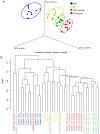Supplementation of triple viable probiotics combined with dietary intervention is associated with gut microbial improvement in humans on a high-fat diet
- PMID: 31452713
- PMCID: PMC6704491
- DOI: 10.3892/etm.2019.7801
Supplementation of triple viable probiotics combined with dietary intervention is associated with gut microbial improvement in humans on a high-fat diet
Abstract
Numerous animal studies have demonstrated that oral probiotics may have a beneficial role in preventing obesity, inflammatory bowel disease and even colorectal cancer, which are all associated with a high-fat diet (HFD). However, the underlying beneficial effects of combined probiotic and dietary intervention on the gut microbiota of 'non-patient' individuals previously on an HFD have yet to be fully elucidated. In the present study, fecal samples were obtained from 36 volunteers on a high-fat diet and after dietary intervention for 4 months, and 16S rDNA sequencing was applied to identify how probiotics and dietary intervention had altered the composition of the microbiota. The results demonstrated that probiotics treatment and dietary intervention in combination raised the diversity of lumen microbes compared with their individual applications. A markedly separated distribution (β-diversity) was observed, confirming the difference in gut microbiota composition among the treatment groups. Bacterial taxonomic analysis demonstrated that the relative abundance of 30 species was altered among the groups following dietary intervention and/or probiotic supplementation. The majority of the species that exhibited a population increase belonged to two butyrate-producing families, Ruminococcaceae and Lachnospiraceae, whereas the species with reduced populations mainly belonged to the Bacteroidaceae family. Collectively, these results suggest that combined probiotic and dietary intervention is able to improve the gut microbiota composition of human subjects on an HFD.
Keywords: community population; dietary intervention; gut microbiota; high-fat diet; probiotics.
Figures




References
LinkOut - more resources
Full Text Sources
